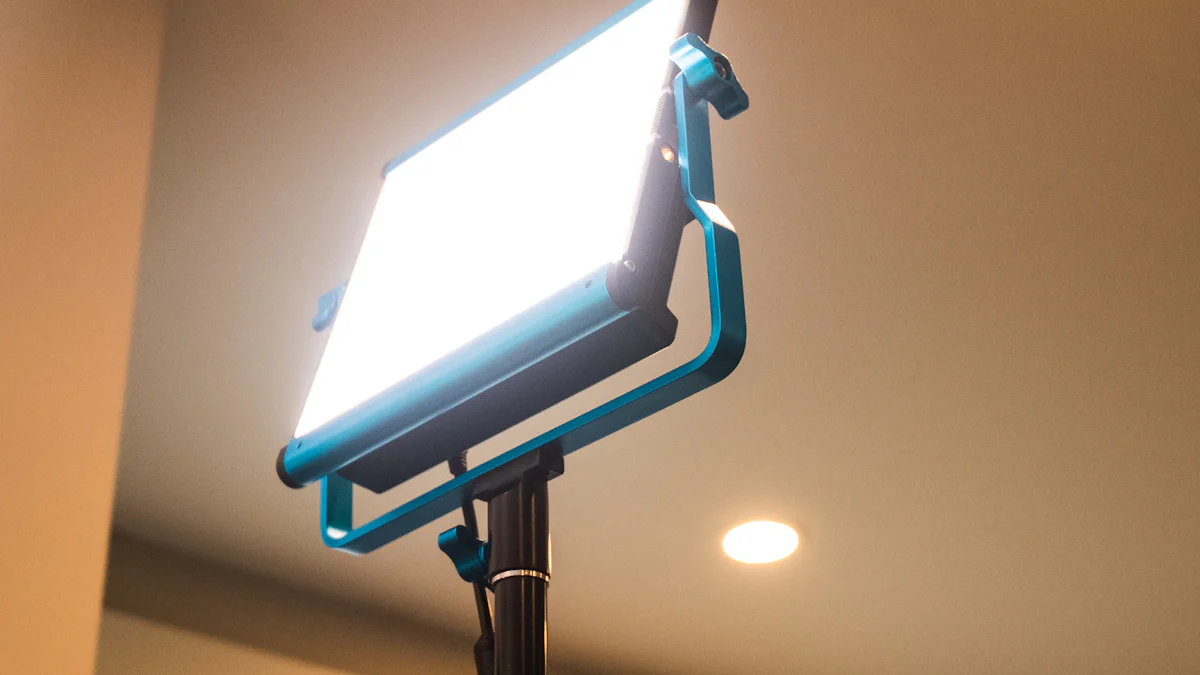Enhancing outdoor spaces with decorative exterior flood lights is not just about aesthetics; it’s a strategic choice that elevates security and ambiance. The installation process, though crucial, can be simplified with the right guidance. By understanding the significance of proper placement and efficient wiring, individuals can maximize the benefits of LED flood lights over traditional options. Embracing these modern solutions ensures cost efficiency and long-term satisfaction in illuminating outdoor areas.
Choosing the Right Location

Assessing Lighting Needs
When determining the ideal location for decorative exterior flood lights, it is essential to assess the specific lighting requirements of the outdoor space. Identifying key areas that require illumination is the first step towards creating a well-lit and visually appealing environment. By pinpointing focal points such as pathways, garden features, or architectural elements, individuals can strategically place their flood lights to enhance these areas effectively.
Furthermore, considering aesthetic appeal plays a significant role in the placement of decorative exterior flood lights. The positioning of these lights should not only serve a functional purpose but also contribute to the overall visual charm of the outdoor setting. By blending practicality with aesthetics, individuals can achieve a harmonious balance between lighting needs and design preferences.
Evaluating Power Sources
Another crucial aspect to consider when choosing the right location for decorative exterior flood lights is proximity to existing power sources. Placing the lights near established power outlets can streamline the installation process and minimize the need for extensive wiring adjustments. This strategic approach not only simplifies the setup but also ensures efficient power supply to the flood lights.
In cases where existing power sources are not readily accessible, planning for new wiring becomes necessary. By anticipating the wiring requirements beforehand, individuals can prepare adequately for any additional electrical work needed to connect their decorative exterior flood lights. This proactive measure helps avoid last-minute complications during installation and ensures a seamless transition to powering up the new lighting fixtures.
Ensuring Optimal Coverage
Achieving optimal coverage with decorative exterior flood lights involves more than just illuminating specific areas; it requires careful consideration of light distribution across the entire outdoor space. Avoiding dark spots is paramount in ensuring consistent brightness levels throughout the area. By strategically placing flood lights to eliminate shadows and dark corners, individuals can create a well-lit environment that enhances both safety and visibility.
Moreover, balancing brightness across different sections of the outdoor space is essential for creating a cohesive lighting scheme. By adjusting the intensity of individual flood lights or incorporating dimmable options, individuals can customize their lighting setup to suit various occasions and preferences. This flexibility allows for dynamic lighting effects that cater to different needs while maintaining overall coherence in illumination levels.
Preparing for Installation
Gathering the necessary tools is a crucial step in preparing for the installation of decorative exterior flood lights. Ensuring that you have all the essential equipment at hand can streamline the process and minimize interruptions. Here is a list of tools you may need:
List of essential tools
- Ladder: To reach elevated areas safely.
- Electric screwdriver: For efficient installation.
- Wire cutters: To trim wires accurately.
- Fish tape: For securing electrical cables.
- Voltage tester: To check power supply.
Safety should always be a top priority when handling electrical installations, especially when working with LED flood lights. Therefore, it is imperative to equip yourself with appropriate safety gear:
Safety equipment
- Insulated gloves: Protect against electric shocks.
- Safety goggles: Shield eyes from debris.
- Hard hat: Ensure head protection.
- Non-slip footwear: Prevent accidents on slippery surfaces.
Turning off the power before commencing any electrical work is a fundamental safety measure that should not be overlooked. Locating the main power switch and verifying that the power is indeed off are critical steps to prevent accidents and ensure a safe working environment.
Locating the main power switch
Before starting the installation process, locate the main power switch in your home’s circuit breaker panel. Switching off the correct circuit ensures that there is no electricity flowing to the area where you will be working.
Verifying power is off
After turning off the main power switch, use a voltage tester to confirm that there is no electrical current present in the circuits you will be working on. This extra precaution helps safeguard against accidental shocks or short circuits during installation.
Removing old fixtures before installing new decorative exterior flood lights is necessary to ensure a clean and secure setup. Following proper procedures when dismantling existing fixtures can prevent damage and simplify the transition to newer lighting options.
Steps to safely remove old fixtures
- Turn off the existing light fixture by switching it off at its designated power source.
- Remove any screws or fasteners securing the fixture in place using an appropriate tool.
- Disconnect the wiring carefully by unscrewing wire nuts and separating individual wires.
- Support the fixture while detaching it from its mounting bracket to avoid dropping or damaging it.
Handling old wiring requires caution and precision to avoid mishaps during removal and replacement processes.
Handling old wiring
- Label wires: Use tags or markers to identify each wire’s purpose for easier reconnection later.
- Inspect for damage: Check for frayed insulation or exposed wires that may pose safety risks.
- Secure loose ends: Bundle loose wires together using zip ties or electrical tape to prevent tangling or accidental contact.
Installation Process

Mounting the Lights
To begin the installation process of decorative exterior flood lights, individuals should first focus on mounting the lights securely in their chosen locations. Following the manufacturer’s instructions is crucial to ensure a proper and stable installation that maximizes the performance and longevity of the flood lights.
Following manufacturer’s instructions
The manufacturer’s guidelines provide essential details on how to correctly position and secure the decorative exterior flood lights. By adhering to these instructions, individuals can avoid common installation mistakes and guarantee that the lights are mounted at optimal angles for effective illumination.
Securing the fixtures
Securing the fixtures in place is a critical step in ensuring their stability and durability over time. Using appropriate tools and hardware recommended by the manufacturer, individuals can fasten the decorative exterior flood lights securely to walls, ceilings, or other surfaces. Properly secured fixtures not only enhance safety but also maintain consistent lighting coverage in outdoor areas.
Wiring the Lights
Once the decorative exterior flood lights are securely mounted, it is time to wire the lights to power sources for activation. Proper wiring is essential for safe operation and efficient functionality of the LED flood lights.
Connecting to power source
Connecting the decorative exterior flood lights to a reliable power source is a fundamental aspect of their installation. Individuals should refer to electrical diagrams provided by manufacturers to identify correct wiring connections. Ensuring that wires are properly connected minimizes risks of electrical hazards and ensures consistent power supply to the flood lights.
Ensuring proper insulation
Proper insulation of wires is crucial for maintaining electrical safety standards during installation. Insulating wire connections with appropriate materials recommended by manufacturers prevents exposure to live currents and reduces risks of short circuits or malfunctions. By following insulation guidelines diligently, individuals can safeguard against potential electrical issues in their outdoor lighting setup.
Testing the Lights
After mounting and wiring the decorative exterior flood lights, it is essential to conduct thorough testing procedures to verify their functionality before finalizing the installation process.
Turning on the power
Turning on the power supply allows individuals to check if all connected fixtures illuminate as intended. This step helps confirm that wiring connections are secure, power sources are functioning correctly, and there are no immediate technical issues affecting light output.
Troubleshooting common issues
In case any problems arise during testing, troubleshooting common issues promptly can help identify underlying causes and implement necessary solutions. Referencing troubleshooting guides provided by manufacturers or seeking professional assistance can aid in resolving technical difficulties efficiently without compromising safety or performance.
By meticulously following each step in mounting, wiring, and testing decorative exterior flood lights during installation, individuals can ensure a seamless transition to enhanced outdoor lighting solutions that elevate both aesthetics and functionality.
Post-Installation Tips
Sealing the Junction Box
To ensure the longevity and performance of your newly installed decorative exterior flood lights, it is imperative to prioritize sealing the junction box effectively. By safeguarding the wiring connections from moisture and environmental elements, you can prolong the lifespan of your lighting setup while maintaining optimal functionality.
Protecting against moisture
Moisture protection is a critical aspect of post-installation maintenance for decorative exterior flood lights. Moisture infiltration can not only compromise the electrical components but also pose safety hazards over time. To protect against moisture, consider using waterproof sealants or silicone caulking to seal the junction box securely. This additional layer of protection acts as a barrier against water ingress, ensuring that your flood lights remain operational in various weather conditions.
Ensuring long-term durability
Long-term durability is key to maximizing the investment in decorative exterior flood lights. Properly sealed junction boxes prevent corrosion and damage to internal wiring, preserving the structural integrity of the lighting fixtures. Regularly inspecting and resealing junction boxes as part of routine maintenance can help identify potential issues early on and address them promptly. By prioritizing durability through effective sealing practices, you can enjoy reliable outdoor lighting solutions for years to come.
Regular Maintenance
Incorporating regular maintenance practices into your post-installation routine is essential for preserving the performance and appearance of your decorative exterior flood lights. By dedicating time to cleaning and inspecting the fixtures, you can ensure optimal functionality and extend their lifespan effectively.
Cleaning the fixtures
Cleaning plays a vital role in maintaining the visual appeal and efficiency of decorative exterior flood lights. Over time, dirt, dust, and debris can accumulate on the light surfaces, diminishing their brightness and overall illumination quality. To clean the fixtures, use a soft cloth or sponge dampened with mild soapy water to gently wipe away any buildup. Avoid harsh chemicals or abrasive materials that may damage the finish or components of the flood lights. Regular cleaning not only enhances aesthetic appeal but also improves light output for a consistently well-lit outdoor environment.
Checking for wear and tear
Regularly checking for wear and tear ensures that your decorative exterior flood lights remain in optimal condition for extended periods. Inspect all components, including housing, lenses, and mounting hardware, for signs of damage or deterioration. Look out for cracks, discoloration, or loose fittings that may indicate potential issues requiring attention. Addressing wear and tear promptly through repairs or replacements can prevent further damage and maintain the performance standards of your outdoor lighting system.
By incorporating post-installation tips such as effective junction box sealing and regular maintenance practices into your outdoor lighting care routine, you can enhance the durability, efficiency, and aesthetics of your decorative exterior flood lights. Prioritizing these essential steps ensures that your investment in quality lighting solutions continues to illuminate outdoor spaces effectively while withstanding environmental challenges over time.
To summarize, selecting the right location and ensuring optimal coverage are crucial steps in installing decorative exterior flood lights effectively. Prioritizing regular maintenance is essential for preserving their efficiency and longevity. By cleaning fixtures, inspecting for wear, and promptly addressing any issues, homeowners can ensure the optimal performance of LED floodlights. Remember, simple actions like these can significantly reduce flood risk and enhance the safety of your outdoor lighting setup. Make regular maintenance a priority to enjoy reliable and efficient decorative exterior flood lights for years to come.
Post time: Jun-18-2024
